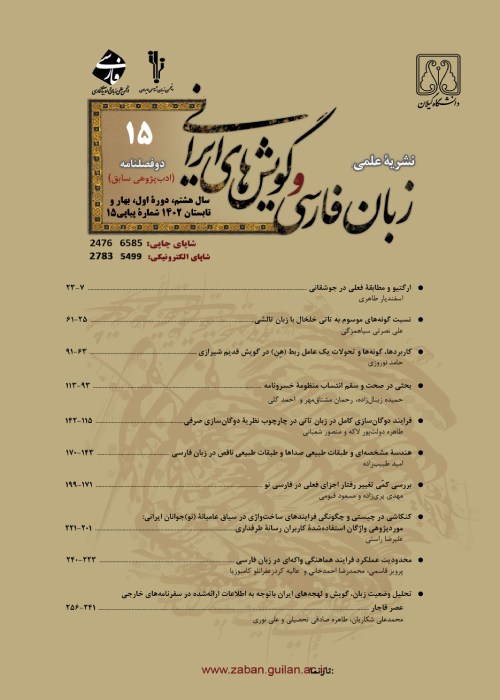A corpus-based study of Persian intonation
Author(s):
Article Type:
Research/Original Article (دارای رتبه معتبر)
Abstract:
Introduction
The present research is a corpus- based study on Persian intonation. Previous studies on Persian intonation have only focused on experimental data and to date few researches have been carried out on Persian intonational patterns as realized in natural spoken corpora. The aim of the present research is to evaluate the intonation patterns of Persian content and grammatical words in a natural spoken corpus. The content words included nouns, verbs, adjectives and adverbs, and the grammatical words included pronouns, prepositions and copular verbs. Earlier researches posit two types of pitch accent in Persian intonatioanl grammar: A bitonal pitch accent, namely L+H* that marks words with stress on a non-initial syllable, together with their enclitics, and a mono-tonal pitch accent, i.e., H* that describes mono-syllabic words or initial-stressed words. The question addressed in the present contribution is to what extent the intonational patterns assumed in the Persian intonation literature may be replicated in studies of Persian natural spoken corpora.
Theoretical framework
This research is based on the Auto-segmental theory of intonation. The intonational structure under this theory is composed of a number of tonal events aligned with specific segmental landmarks. The most important tonal events are pitch accents and boundary tones. Pitch accents are associated with stressed syllables while boundary tones are aligned with the boundary of prosodic units. These tonal events are called tonal targets as they are linked with specific segmental landmarks in the speech signal. The auto-segmental theory of intonation posits six pitch accents namely H*، L*،L+H*، L*+H، H+L*، H*+L.Among these pitch accents, L* and H* are mono-tonal, while L+H*، L*+H، H+L*، H*+L are bitonal. A mono-tonal accent is one which is composed of either a single high (H*) or low (L*) tone. Bitonal accents, on the other hand, are compound tones made of a combination of a low and a high tone, irrespective of their order.
Methodology
The Methodology of the research is descriptive. A number of Persian content words, including nouns, verbs, adjectives and adverbs, and grammatical words including pronouns, prepositions and copular verbs, were randomly selected from 104 utterances from FarsDat (Farsi spoken language database). All the utterances had been spoken by native speakers of Persian speaking the standard dialect of Tehrani Farsi. The target words, content and grammatical, were segmented from the acoustic signals of the utterances for further analysis. All acoustic parameters were measured using Praat software, version 5.2.12. Measurements were made simultaneously on F0 contour and spectrograph. The F0 patterns of the target words were investigated to see whether they bear a pitch accent, and if they do, what kind of pitch accent they are most associated with.
Results and discussion
The results suggested that while content words usually receive pitch accents, grammatical words are rarely produced with a pitch accent. The findings further suggested that the morpho-syntactic category of a given word is unable to affect its tonal pattern. The distribution of the pitch accent types H* and L*+H revealed that Persian words are most often produced with the L*+H accent type, irrespective of their lexical stress pattern, and that the H* is used in initial-stressed words only when the segmental condition for the realization of the L tone is not satisfied. It was also argued that the alignment of the H tone in L*+H accent is affected by the presence or absence of enclitics in a word: In words with an affixed enclitic, the H peak is delayed, and realized in the post-accented syllable, while in words with no enclitic pronoun, the peak is realized on the accented syllable with no delay.
Conclusion
Overall, the findings of the present research indicated that all Persian words, irrespective of their stress pattern receive the bitonal pitch accent L*+H, and the pitch accent H*is realized on words with initial stress only when the phonological condition for the realization of the L tone is not met.Keywords:
Language:
Persian
Published:
Journal of Persian language and Iranian dialects, Volume:3 Issue: 2, 2019
Pages:
35 to 54
magiran.com/p2008718
دانلود و مطالعه متن این مقاله با یکی از روشهای زیر امکان پذیر است:
اشتراک شخصی
با عضویت و پرداخت آنلاین حق اشتراک یکساله به مبلغ 1,390,000ريال میتوانید 70 عنوان مطلب دانلود کنید!
اشتراک سازمانی
به کتابخانه دانشگاه یا محل کار خود پیشنهاد کنید تا اشتراک سازمانی این پایگاه را برای دسترسی نامحدود همه کاربران به متن مطالب تهیه نمایند!
توجه!
- حق عضویت دریافتی صرف حمایت از نشریات عضو و نگهداری، تکمیل و توسعه مگیران میشود.
- پرداخت حق اشتراک و دانلود مقالات اجازه بازنشر آن در سایر رسانههای چاپی و دیجیتال را به کاربر نمیدهد.
دسترسی سراسری کاربران دانشگاه پیام نور!
اعضای هیئت علمی و دانشجویان دانشگاه پیام نور در سراسر کشور، در صورت ثبت نام با ایمیل دانشگاهی، تا پایان فروردین ماه 1403 به مقالات سایت دسترسی خواهند داشت!
In order to view content subscription is required
Personal subscription
Subscribe magiran.com for 70 € euros via PayPal and download 70 articles during a year.
Organization subscription
Please contact us to subscribe your university or library for unlimited access!


